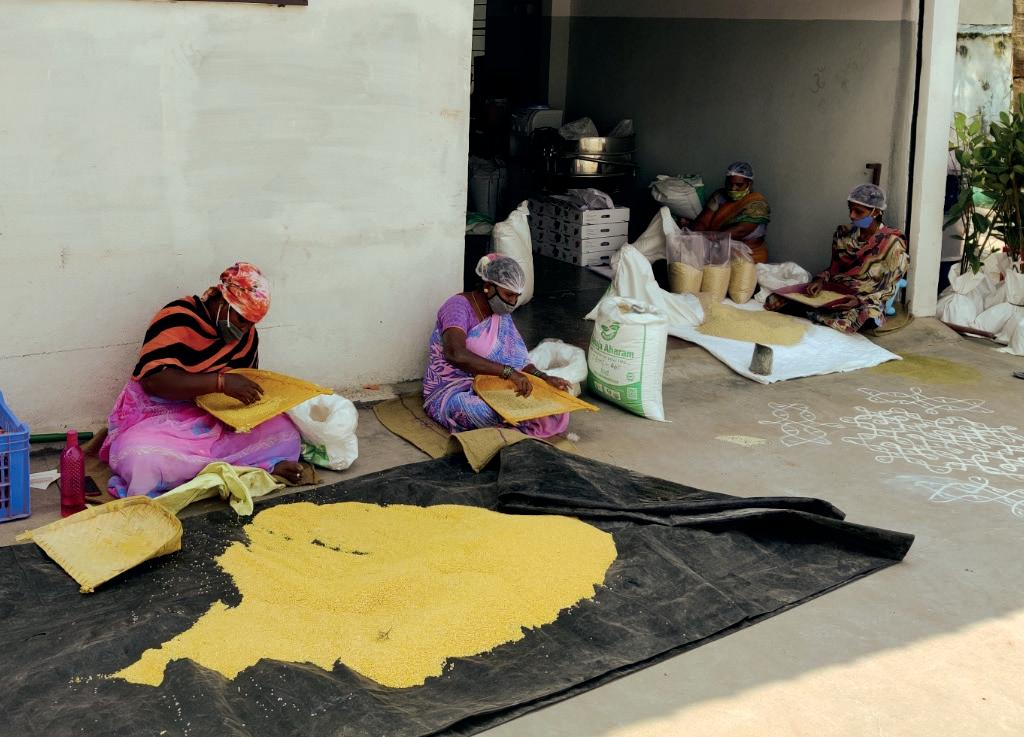Essayer OR - Gratuit
Organic takeover
Down To Earth
|August 16, 2022
A federation of farmer-producer organisations taps into the growing organic market to help members raise incomes

CATERING DIRECTLY to the consumers' needs assures better marketability and incomes. This is what nearly 10,000 farmers of Telangana and Andhra Pradesh have realised over the past decade and are now steering a silent organic movement.
It all began in 2009, when a group of consumers in Hyderabad, then part of unified Andhra Pradesh, established a cooperative society to source chemical-free produce directly from farmers. Operating under the guidance of the Centre for Sustainable Agriculture (CSA), a Hyderabad-based research nonprofit, the cooperative society over a period of time roped in a few farmers and began to sell the produce through a farmer-run retail store in Secunderabad and mobile retail vans that travelled to urban areas. Soon, more and more organic farmers joined the cooperative society and what had started off as a consumers' initiative became a farmers' group. In 2013, when the government floated the concept of farmer producer organisation (FPO) to aggregate collection of produce and create market links for better prices under the Companies Act of 2013, CSA and the cooperative society saw this as an opportunity.

Cette histoire est tirée de l'édition August 16, 2022 de Down To Earth.
Abonnez-vous à Magzter GOLD pour accéder à des milliers d'histoires premium sélectionnées et à plus de 9 000 magazines et journaux.
Déjà abonné ? Se connecter
PLUS D'HISTOIRES DE Down To Earth

Down To Earth
COP OF TALK
The UN's 30th climate summit, COP30 in Belém, was billed as the COP of truth and implementation.It was an opportunity for the world to move beyond diagnosis to delivery. Instead it revealed a system struggling to prove its relevance.
14 mins
December 01, 2025
Down To Earth
1,500 days, and an alarm for new climate
SEASONS ARE the compass that guide humans to survive and thrive as a society. What happens if seasons lose their distinct character and predictable rhythm? This is no longer a theoretical question. The Earth is entering a new climate regime, its atmosphere now saturated with greenhouse gases at levels without precedent in human history. And the earliest sign of this shift is the near-dissolution of familiar seasons; all merging and dissipating like the pupa inside the chrysalis, but, not to give birth to that mesmerising butterfly. This metamorphosis is manifest in the blizzard of weather events, extreme in severity and unseasonal by nature and geography.
2 mins
December 01, 2025

Down To Earth
Rights in transit
A recent dispute over transport and trade of kendu leaves in Odisha highlights differing interpretations of forest rights laws in the state
6 mins
December 01, 2025
Down To Earth
Roots of peace
Kerala's forest department plants fruit and fodder trees to ease human-wildlife tensions
2 mins
December 01, 2025

Down To Earth
Flattened frontiers
Efforts to reclaim degraded land from Chambal ravines expose both people and biodiversity to ecological risks from erosion and flooding
5 mins
December 01, 2025

Down To Earth
INDIA'S DRY RUN
India is poised to be a global hub of data centres—back-end facilities that house servers and hardware needed to run online activities.
21 mins
December 01, 2025

Down To Earth
Bangla generic drugs to the rescue
A buyer's club for generic cystic fibrosis drugs sourced from Bangladesh highlights the country's laudable pharma development
4 mins
December 01, 2025

Down To Earth
Direct approach
A new direct cash transfer scheme as well as decades of women-centric programmes yield an electoral windfall for the ruling alliance in Bihar
5 mins
December 01, 2025

Down To Earth
HIDDEN RESOURCE
Punjab's 1.4 million abandoned borewells offer a chance to mitigate flood damage and replenish depleting groundwater
4 mins
December 01, 2025
Down To Earth
Corporate bias
INDIA'S DRAFT Seeds Bill, 2025, introduced by the Centre in mid-November, proposes a few key changes.
1 min
December 01, 2025
Translate
Change font size
